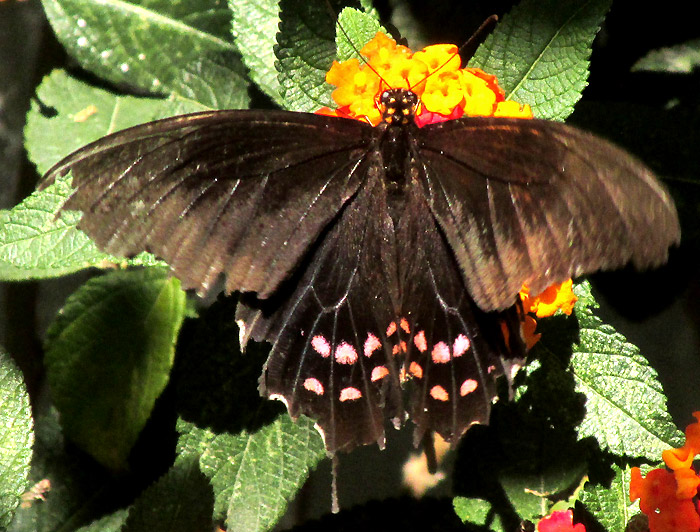Excerpts from Jim Conrad's
Naturalist Newsletter
Entry dated July 28, 2023, issued from near Tequisquiapan, elevation about 1,900m (6200 ft), Querétaro state, MÉXICO
(~N20.57°, ~W99.89°)
PINK-SPOTTED SWALLOWTAIL

In a backyard enclosed by high stone wall, at the edge of a small village beside a gully with Smooth Mesquite the dominate vegetation, the above somewhat tattered butterfly was taking nectar from a planted lantana. For several minutes the butterfly flitted from flower cluster to flower cluster, at each stop spending maybe 15-20 seconds fluttering the wings very fast, holding itself in the same location above the lantanas. In bright sunlight, the spots were reddish, and sparkled.
Having seen it so often, I'd been assuming that this was the same species commonly noticed in other parts of Mexico. However, eventually it occurred to me that the extended periods of hovering while rapidly fluttering, combined with the sparkling reddish dots, seemed unusual. The above image was sent to volunteer butterfly identifier Bea in Ontario, who figured out that it's the aptly named Pink-spotted Swallowtail, PAPILIO ROGERI.
The Butterflies and Moths of North America webpage for Pink-spotted Swallowtail tells us that the species' caterpillar stage feeds on citrus, of which several trees occur in the little backyard, with the general habitat being woods edges. It also reports that the species' conservation status rank is NCGR: G3, defined as "Very rare or local throughout its range or found locally in a restricted range (21 to 100 occurrences). (Threatened throughout its range)."
On the GBIF Occurrences page for Papilio rogeri it's shown that the species has been observed throughout most of Mexico and as a stray in the US along Texas's Rio Grande border. It also reports two subspecies. Ours is the subspecies pharnaces found throughout Mexico and straying into Texas, while the type subspecies rogeri turns up only in the Yucatan Peninsula.
Several swallowtail species are common and widespread, so why is our pink-spotted one so uncommon? In Gerald Einem's 2004 study "Oviposition and Early Stages of Pink-spotted Swallowtail, Papilio rogeri, in México," it was noted that when the female deposits her eggs on the underside of citrus leaves she takes a long time (51 minutes during his observation) and tends to complete the process once its begun, despite the observer coming close and touching her. The female, then, seems to make herself very vulnerable to predators.
The author suggests that the species "... may be considered aposematic, that is warningly colored and unpalatable due to endogenous synthesis of toxins or larval feeding on unpalatable substances obtained from the host plant." He further thinks that the species may have evolved to look like the very similar Parides photinus, which occurs in the same region, and feeds on Dutchman's Pipe vines, Aristolochia. Dutchman's Pipes are known to be toxic, and may impart their toxicity to caterpillars who feed on them. Predators might know to avoid butterflies looking like this.